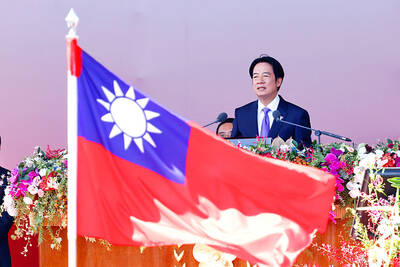Amid speculation that China has completed a prototype of a stealth aircraft that experts say could rival the US Air Force’s F-22 — the world’s only fully operational next-generation stealth fighter aircraft — national defense officials yesterday said they doubted the Chinese aircraft would be operational any time soon and raised doubts as to the veracity of information made public about the plane.
Deputy Chief of the General Staff for Intelligence at the Ministry of National Defense Shen Yi-ming (沈一鳴) said photographs, purportedly of the Chengdu J-20 aircraft, had generated speculation that China had entered the testing phase for the fifth-generation aircraft.
However, the authenticity of the photographs was “questionable,” Shen told the legislature’s Foreign and National Defense Committee.
Photographs published online and Chinese military sources cited by Japanese media last week seemed to indicate that a prototype version of the J-20 fighter had been completed, with taxi tests carried out last week in southwestern China.
The news came days before a visit to Beijing by US Secretary of Defense Robert Gates, who will seek to repair military ties cut off a year ago by China when Washington sold billions of dollars worth of arms to Taiwan, as well as a visit by Chinese President Hu Jintao (胡錦濤) to Washington.
The J-20 would come equipped with potent missiles and could reach the US territory of Guam with aerial refueling, although it would take between 10 and 15 more years to develop technology on a par with that of the F-22, reports said.
Defense industry publication Aviation Week said the J-20 was larger than expected — suggesting a long-range capability and the ability to carry heavy weapon loads.
Quoting Chinese military sources, the Asahi Shimbun reported that the People’s Liberation Army Air Force (PLAAF) planned to begin test flights of the J-20 as soon as this month, with plans to deploy the jet as early as 2017.
The J-20 “will become fully competitive with the F-22, in capability and perhaps in numbers, around the end of this decade,” Rick Fisher, an expert on the Chinese military at the International Assessment and Strategy Center, a US think tank, told Agence France-Press.
Dennis Blasko, a specialist on the PLA, said the timeline for development of the aircraft was “probably considerably longer than what most outside observers would estimate.”
Chinese Nationalist Party (KMT) Legislator Lin Yu-fang (林郁方) also played down the speculation about the fighter jet.
Lin said the emblem on the tail fin of the aircraft was not consistent with that of the PLAAF and that the emblems on the front wings were of a design no longer used.
Shen, who said Lin’s observations were “basically correct,” added that Russian analysis showed that China still lagged technologically in terms of manufacturing engines, radar, composite materials, instrumentation and electrical systems.
Asked by Lin if he believed China was incapable at this point of producing the J-20, Shen said he believed that was the case.
Western military experts have also expressed doubts over the J-20.
“I have yet to see proof of a test flight and testing for a prototype can take quite some time before production begins,” Blasko said.

People can preregister to receive their NT$10,000 (US$325) cash distributed from the central government on Nov. 5 after President William Lai (賴清德) yesterday signed the Special Budget for Strengthening Economic, Social and National Security Resilience, the Executive Yuan told a news conference last night. The special budget, passed by the Legislative Yuan on Friday last week with a cash handout budget of NT$236 billion, was officially submitted to the Executive Yuan and the Presidential Office yesterday afternoon. People can register through the official Web site at https://10000.gov.tw to have the funds deposited into their bank accounts, withdraw the funds at automated teller

PEACE AND STABILITY: Maintaining the cross-strait ‘status quo’ has long been the government’s position, the Ministry of Foreign Affairs said Taiwan is committed to maintaining the cross-strait “status quo” and seeks no escalation of tensions, the Ministry of Foreign Affairs (MOFA) said yesterday, rebutting a Time magazine opinion piece that described President William Lai (賴清德) as a “reckless leader.” The article, titled “The US Must Beware of Taiwan’s Reckless Leader,” was written by Lyle Goldstein, director of the Asia Program at the Washington-based Defense Priorities think tank. Goldstein wrote that Taiwan is “the world’s most dangerous flashpoint” amid ongoing conflicts in the Middle East and Russia’s invasion of Ukraine. He said that the situation in the Taiwan Strait has become less stable

REASSURANCE: The US said Taiwan’s interests would not be harmed during the talk and that it remains steadfast in its support for the nation, the foreign minister said US President Donald Trump on Friday said he would bring up Taiwan with Chinese President Xi Jinping (習近平) during a meeting on the sidelines of the APEC Summit in South Korea this week. “I will be talking about Taiwan [with Xi],” Trump told reporters before he departed for his trip to Asia, adding that he had “a lot of respect for Taiwan.” “We have a lot to talk about with President Xi, and he has a lot to talk about with us. I think we’ll have a good meeting,” Trump said. Taiwan has long been a contentious issue between the US and China.

FRESH LOOK: A committee would gather expert and public input on the themes and visual motifs that would appear on the notes, the central bank governor said The central bank has launched a comprehensive redesign of New Taiwan dollar banknotes to enhance anti-counterfeiting measures, improve accessibility and align the bills with global sustainability standards, Governor Yang Chin-long (楊金龍) told a meeting of the legislature’s Finance Committee yesterday. The overhaul would affect all five denominations — NT$100, NT$200, NT$500, NT$1,000 and NT$2,000 notes — but not coins, Yang said. It would be the first major update to the banknotes in 24 years, as the current series, introduced in 2001, has remained in circulation amid rapid advances in printing technology and security standards. “Updating the notes is essential to safeguard the integrity